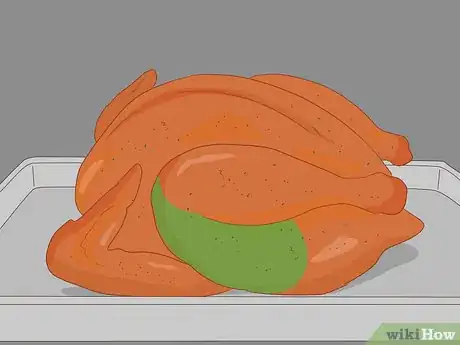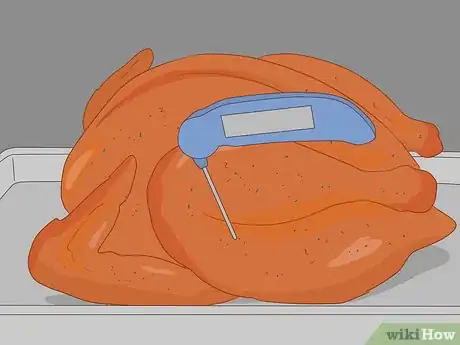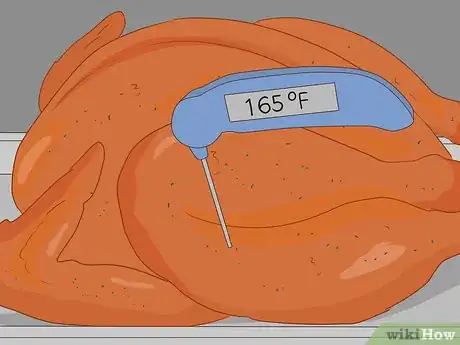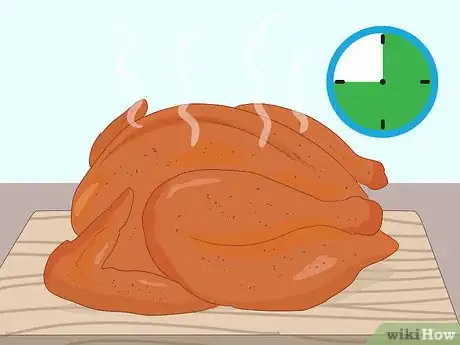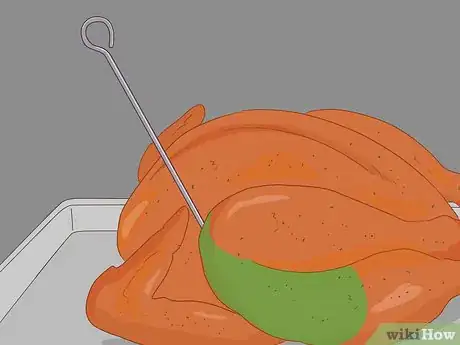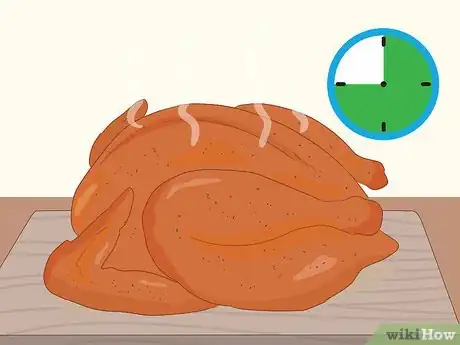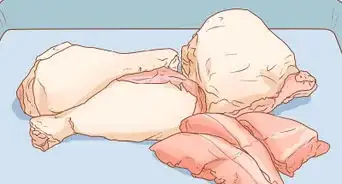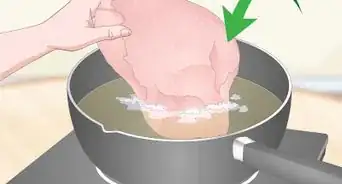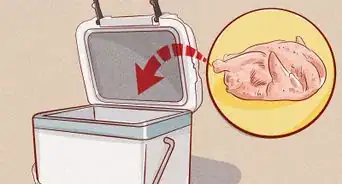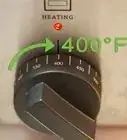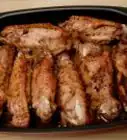This article was co-authored by Ollie George Cigliano and by wikiHow staff writer, Jessica Gibson. Ollie George Cigliano is a Private Chef, Food Educator, and Owner of Ollie George Cooks, based in Long Beach, California. With over 20 years of experience, she specializes in utilizing fresh, fun ingredients and mixing traditional and innovative cooking techniques. Ollie George holds a BA in Comparative Literature from The University of California, Berkeley, and a Nutrition and Healthy Living Certificate from eCornell University.
This article has been viewed 44,192 times.
You've spent hours getting a delicious turkey ready for one of the biggest meals of the year. Now it's time to decide whether to pull the turkey out of the oven or leave it to cook longer. If you have a thermometer, you can easily see if the turkey has reached the food-safe temperature of 165 °F (74 °C). Don't worry if you don't have a thermometer; you can check to see if the turkey's juices run clear.
Steps
Using a Thermometer
-
1Locate the turkey's thigh. To find the thighs, look for the drumsticks. The thigh will be directly below the drumstick and next to the breast on both sides of the turkey.[1]
- The thighs are dark meat, which take longer to cook than white meat, such as the breasts.
-
2Insert a thermometer into the thickest part of the thigh. You can use a standard or instant-read meat thermometer to determine the turkey's internal temperature.[2] Insert the thermometer into the thickest part of the thigh that's directly below the leg.[3]
- Ensure that the thermometer isn't touching a bone, which could give your thermometer a false reading.
Did You Know? Pop-up thermometers that are included in some turkeys are often inaccurate or they only pop up once the turkey has reached 178 °F (81 °C).
Advertisement -
3Check to see if the turkey has reached 165 °F (74 °C). Leave the thermometer in the thigh until it's registered the internal temperature. You can remove the turkey from the oven once it reaches 165 °F (74 °C) and stays at that temperature for at least 1 minute.[4]
- Keep in mind that the turkey will continue to cook once you remove it from the oven, so don't cook your turkey beyond 165 °F (74 °C) or the meat will become dry.
-
4Remove the turkey and rest it for 45 minutes. Turn off the oven and remove the roasting pan. Transfer the turkey to a cutting board and let it rest while you prepare gravy. Once the turkey has rested for 45 minutes, you can carve it.[5]
- The juices within the turkey will redistribute while the turkey rests. This will prevent the juices from running out of the turkey as soon as you start carving it.
- Since most turkeys are large and will retain heat, there's no need to cover the turkey while it rests.
Estimating Without a Thermometer
-
1Find the thighs on the turkey. If you don't have a thermometer, you'll need to determine if the turkey is done based on the part of the turkey that takes the longest to cook. Look directly below the drumsticks and next to the breasts to find the turkey's thighs.[6]
- Since thigh meat is muscular and dark, it takes the longest time to cook.
-
2Insert the tip of a knife or a skewer into the thigh. Poke the knife or skewer into the crease between the thigh and the breast. This will probably be covered with skin that you'll have to cut through.[7]
- You don't need to cut very deep into the thigh. Cut about 2 inches (5.1 cm) or until you see the juices start to run out.
-
3Look for clear juices. Once you've inserted the knife or skewer into the thigh, you should see juices run out. If the juices are clear, the turkey has finished cooking.[8] If you see blood or slightly red juices, the turkey isn't done.[9]
Tip: If the turkey hasn't finished cooking, return it to the oven and check it again in 20 minutes.
-
4Rest the turkey for 45 minutes once the juices run clear. Turn off the oven and take the roasting pan out of the oven. Then put the turkey on a cutting board and let it rest, so the juices redistribute within the meat.
- Make a gravy with the pan juices while you wait to carve the turkey.
Things You'll Need
Using a Thermometer
- Meat thermometer
- Knife
- Cutting board
Estimating Without a Thermometer
- Knife or skewer
- Cutting board
References
- ↑ https://www.thekitchn.com/how-to-check-the-temperature-on-a-turkey-cooking-lessons-from-the-kitchn-102442
- ↑ Ollie George Cigliano. Private Chef & Food Educator. Expert Interview. 30 August 2021.
- ↑ https://www.thekitchn.com/how-to-check-the-temperature-on-a-turkey-cooking-lessons-from-the-kitchn-102442
- ↑ https://www.thekitchn.com/take-the-guesswork-out-of-cooking-meat-with-this-guide-222578
- ↑ https://www.cooksillustrated.com/articles/102-how-to-temp-and-rest-your-turkey
- ↑ https://www.thekitchn.com/how-to-check-the-temperature-on-a-turkey-cooking-lessons-from-the-kitchn-102442
- ↑ https://www.bbc.com/food/techniques/testing_cooked_poultry
- ↑ Ollie George Cigliano. Private Chef & Food Educator. Expert Interview. 30 August 2021.
- ↑ https://www.bbc.com/food/techniques/testing_cooked_poultry
